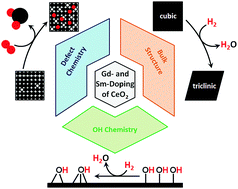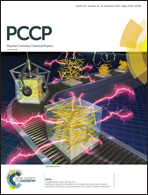H2 reduction of Gd- and Sm-doped ceria compared to pure CeO2 at high temperatures: effect on structure, oxygen nonstoichiometry, hydrogen solubility and hydroxyl chemistry
Abstract
The effect of Gd- and Sm-doping on pure CeO2 with respect to crystal structure, oxygen nonstoichiometry, hydrogen solubility and hydroxyl chemistry in a hydrogen atmosphere at elevated temperatures was studied using a combination of powder X-ray diffraction (XRD), temperature-programmed methods (such as reduction, desorption and oxidation), and Fourier-Transform Infrared Spectroscopy (FT-IR). In particular, Gd0.1Ce0.9O2−δ (GDC10) and Sm0.15Ce0.85O2−δ (SDC15) were compared to pure CeO2. After H2 reduction of GDC10/SDC15/CeO2 at 900 °C, two distinct phases form, which differ from each other in terms of oxygen nonstoichiometry. One phase is only slightly reduced and maintains a cubic fluorite unit cell. The other phase is strongly oxygen depleted and changes its lattice to triclinic. Enrichment or depletion of the dopants in the two phases upon reduction was not observed. No evidence for a long-range ordered cerium hydride could be found, despite the fact that all samples clearly incorporate hydrogen during the reduction procedure. Generally, the treatment of all three samples with flowing H2 at 700 °C, 800 °C and 900 °C causes the oxygen deficiency and the amount of bound hydrogen to increase with reduction temperature. Acceptor doping, thus, promotes hydrogen incorporation, but it at the same time decreases the amount of reactive oxygen. In conclusion, the study of hydroxyl chemistry shows that doping CeO2 with Gd or Sm creates binding sites for reactive hydroxyl groups that are not observed for pure CeO2. The distinct infrared absorption peak at ca. 2127 cm−1 – which originates from an electronic transition of Ce3+ (2F5/2 → 2F7/2) – is a viable indicator for the reduction degree of all three specimens.



 Please wait while we load your content...
Please wait while we load your content...